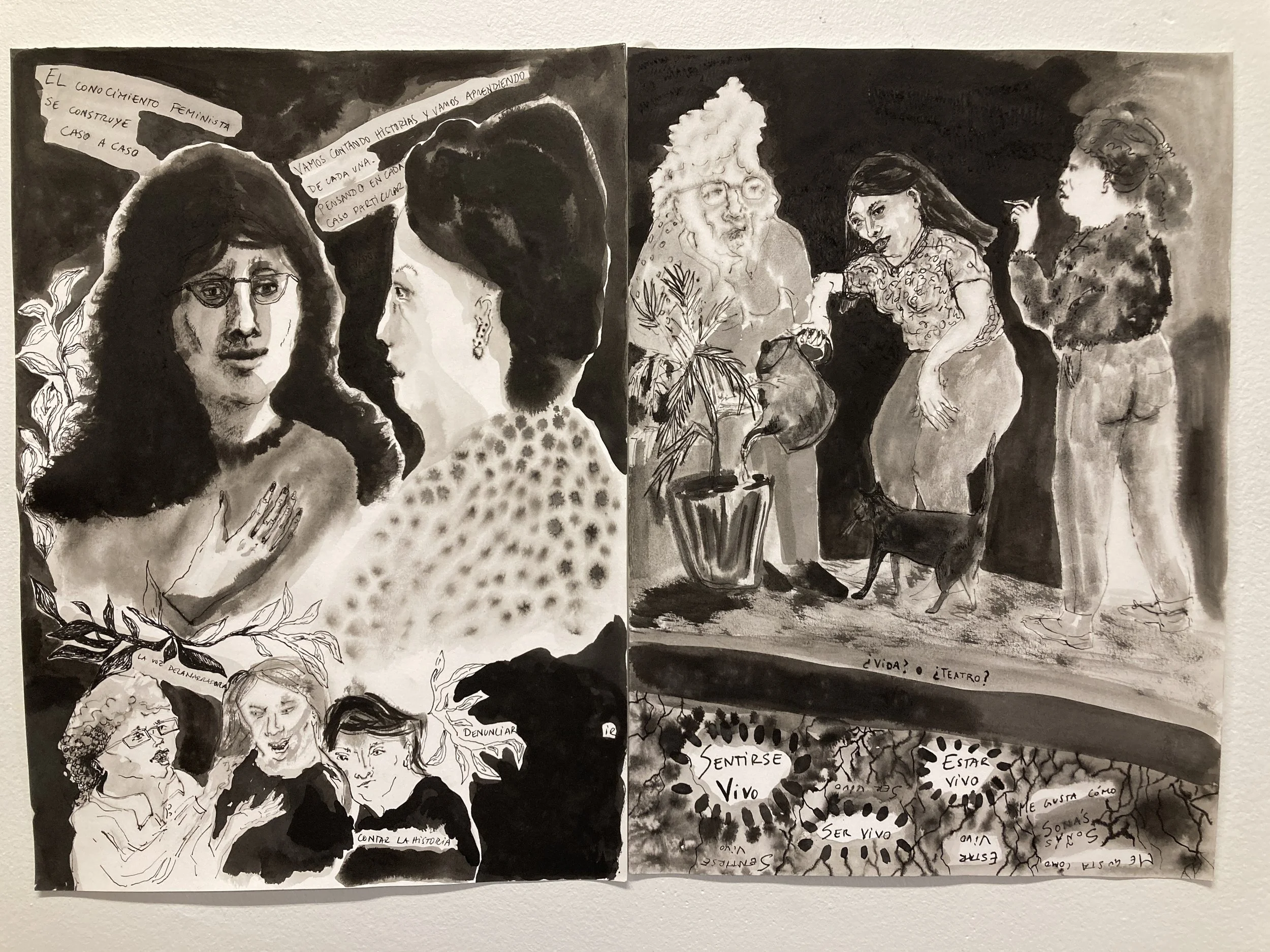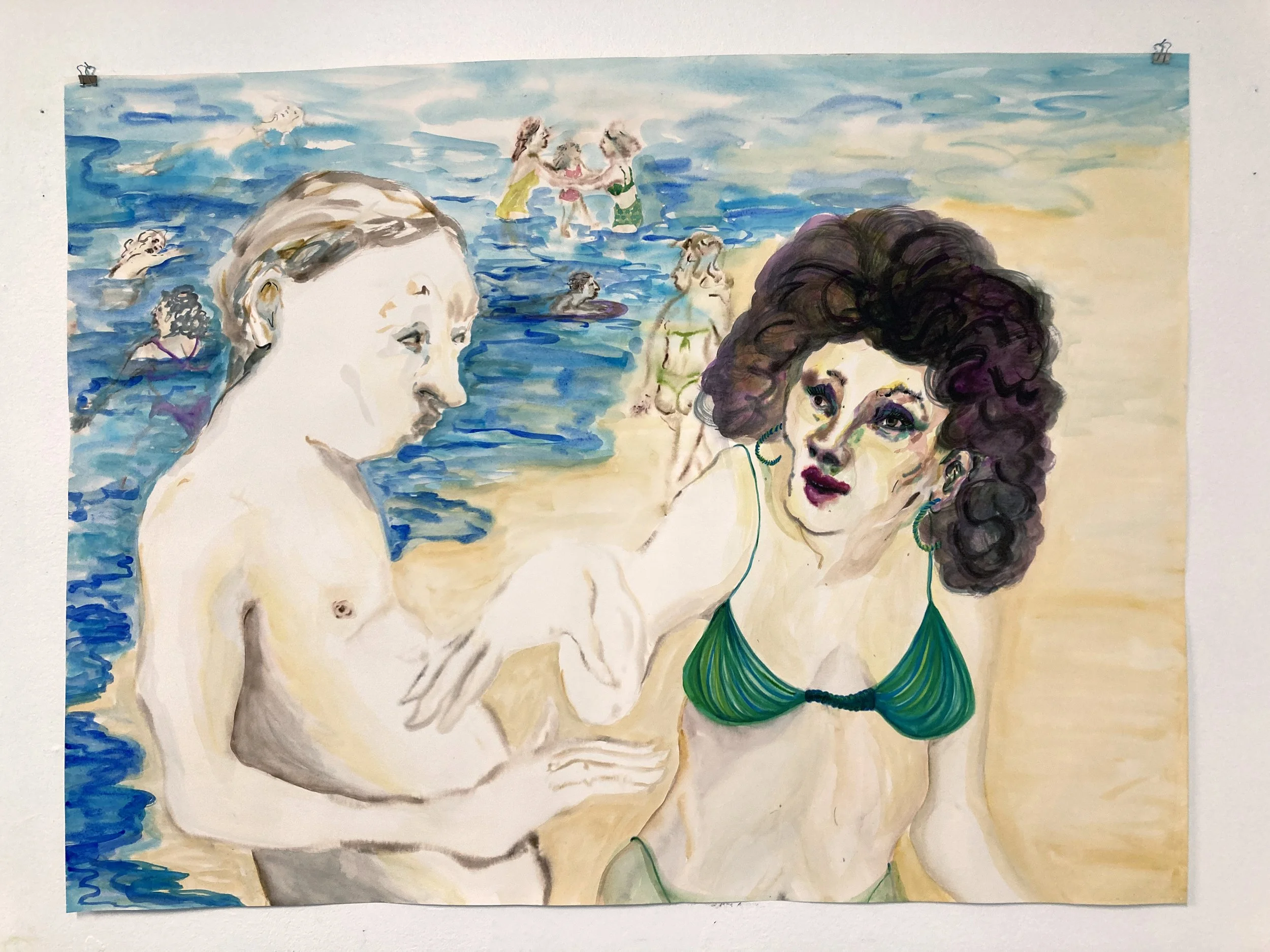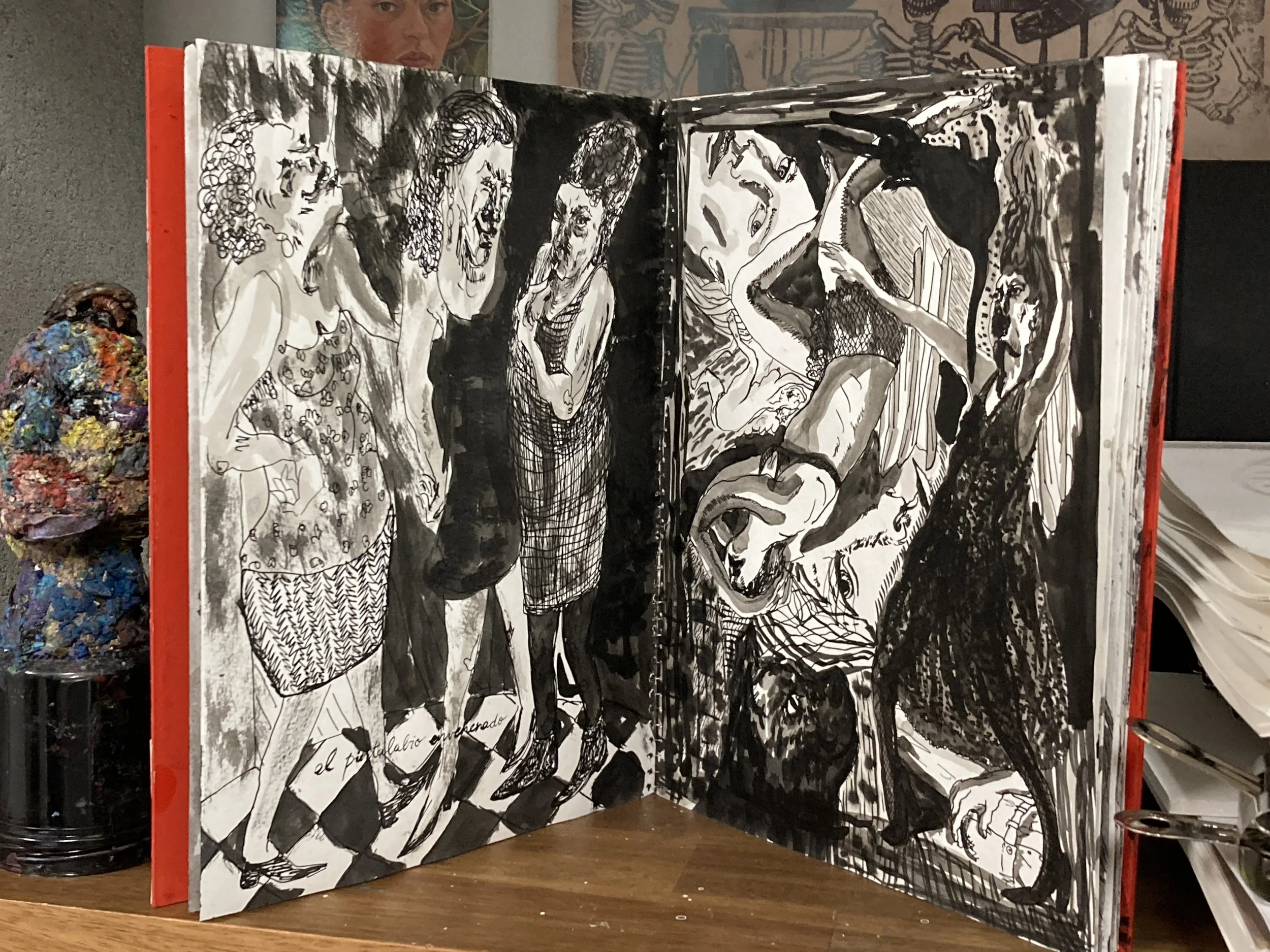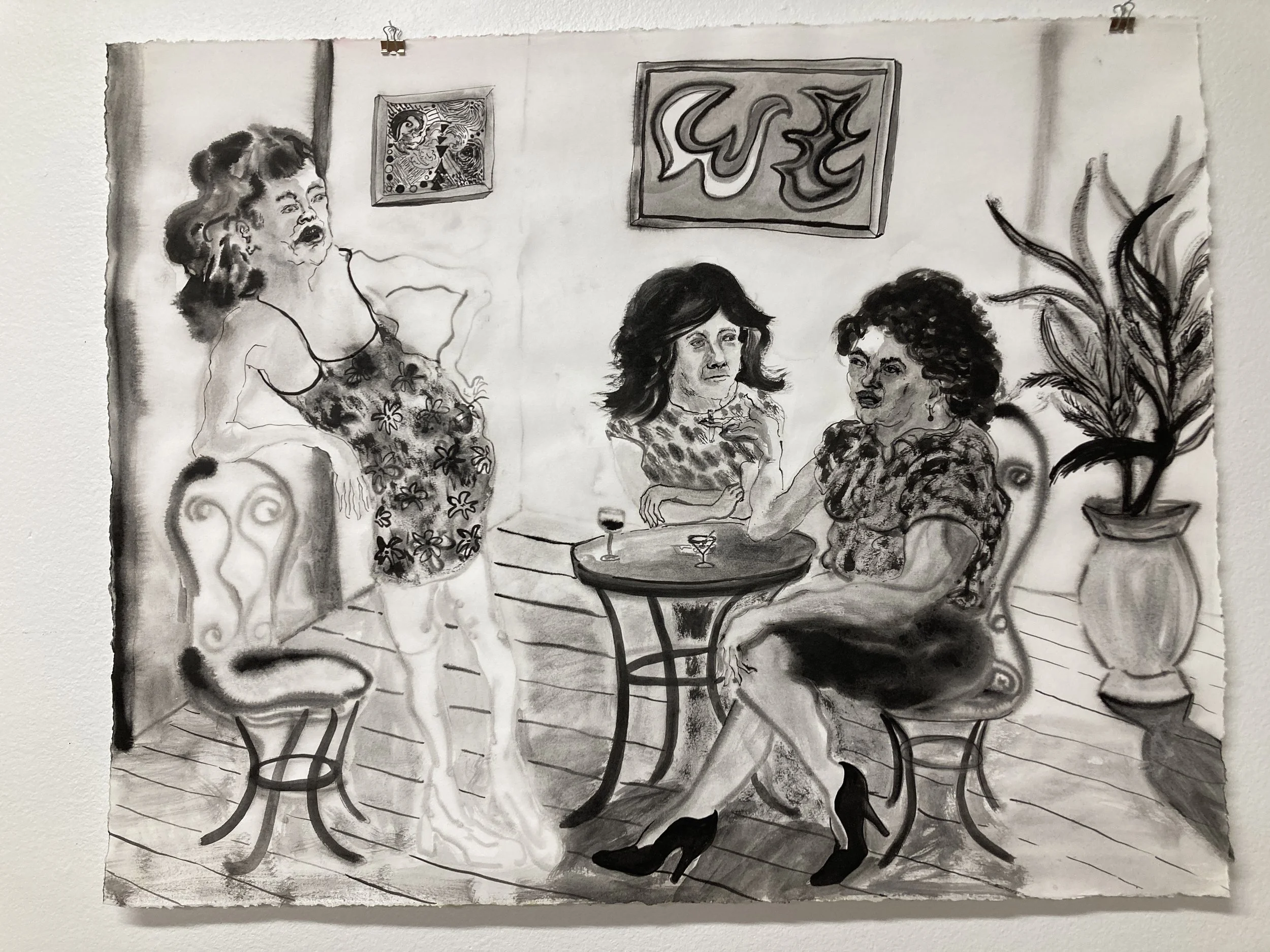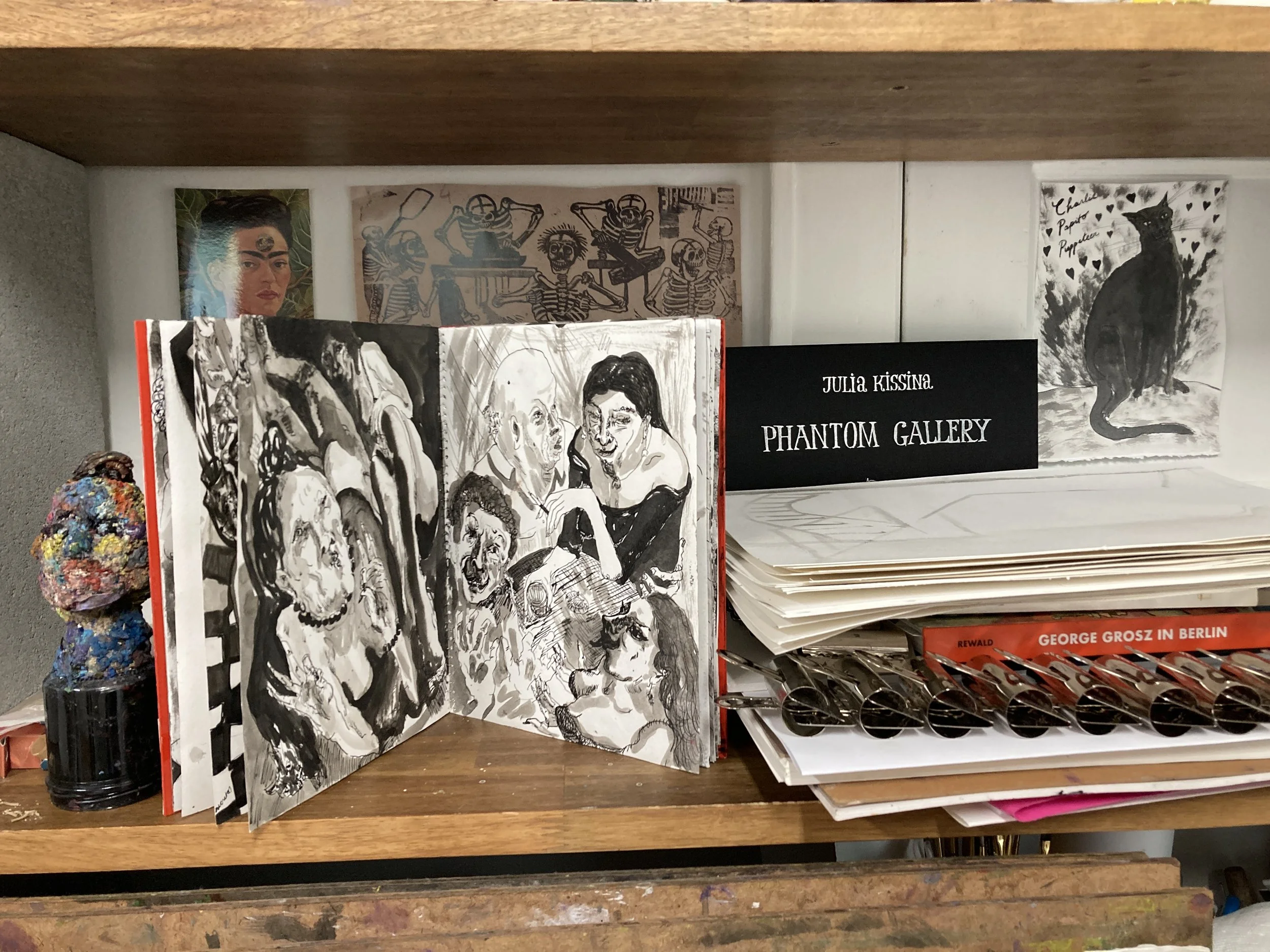Maria Korol
On May 6, 2023, Seek ATL visited the studio of artist Maria Korol. You can listen to and/or read a curated selection of the transcript of our visit below.
SeekATL members in Maria Korol’s studio
Audio recording picks up mid-conversation during the visit….
Maria Korol (MK): The best translator of my work is Shoshana [she is the mother of Maria’s student Chavi]. If she were here, she would tell you what each person in my drawings is thinking and saying. *group laughter* And she nails it even more than I can.
And it's like, you know, she's not from Argentina. She doesn't speak Spanish, but she KNOWS. *group laughter* She’s a woman, an intelligent woman, who picks up on certain things. And yeah, like when I had this show at Swan [Coach House], Shoshana was telling me everything that was happening [in the drawings]. .
I was like, “I need to record you. Can I please record all the things that my characters are saying? Because that's IT!” *group laughter*
Watercolor drawing by Maria Korol
SeekATL Member (SK): Are you really into films and TV?
MK: Yes!
SK: There's something about the “moment” in your work. It's about these constructed moments. And that makes sense that you don't like the hyper-realistic stuff that's [very] composed, that's sort of out of time [with what] you've created.
When you've talked about liking, having a background in dance…dance is so much of the moment. It's so hard to capture what happens in dance, besides the experience of the performance, because it's the body plus movement. And then film is the body plus time. And so, you're creating…capturing these little, tiny snapshots of…I don’t know…
MK: The way that Pedro Almodovar, a Spanish filmmaker, represents women, and especially aging women, is amazing, you know. Latin American women, when we age, instead of going to neutral colors and fading off, it’s the opposite, you know, [we put] bright green shade on the eyes, [red lipstick]—we need all these things for more visibility. He does that so well, and his shots are gorgeous. So, yes, film, definitely.
SK: Yeah, and it's sort of like the punk aesthetic of it as well, and that when I see the ones with the writing, they look like, oh, this one looks like a zine, you know?
Ink Drawings by Maria Korol
MK: Yeah, oppositional. One time I taught a class on women filmmakers, and we read about the oppositional gaze [in an essay by bell hooks] and that really spoke to me. As women we live under the male gaze, kind of performing for it…even if you don't want to, you're so tied by it, even in the way that you look at yourself in the mirror.
And the oppositional gaze [allows you to] say, you know what, I have a right to look back and have my own way of looking, my own way of appreciating different things. And that's why what Yoon said was moving to me because, yes, I love distortion. People are weird, you know, we're all pretty weird looking.
Watercolor drawing by Maria Korol
SK: But there’s no self-consciousness to any of them, which is what makes it so much of a resistance…the distortion is like resisting all of that expectation, all of that pressure and it's just lovely and even like in the beach [drawing]; it almost feels like an animation, like the skin is wiggling away from the touch. In a totally non-human way, but I understand exactly that feeling, like wriggling away from an unwanted touch, and resisting it. And I love that. It's so great: that sort of owning every bulgy arm or long finger... They are so unself-conscious, I love it.
MK: I make them occupy space on the canvas or on the paper [so they can] be real comfortable. Even if they have their distortions, like we all do, they're, like you said, comfortable, and [it’s like] they're saying, “I'm in charge.”
SK: Is there any film related to this series or this work like there was in the past, like animations?
MK: There is, oh, do you want me to show you something that I'm working on?
Well, I can't show you the whole thing because it's still in progress, but yes, speaking of animated work... I have a show coming up in [Linz] Austria and I'm going to send a video that I'm working on, because I do interdisciplinary art. So [this is like] going back to dance [but] in the stupidest way possible…*group laughter*
I'm going to have these little [drawn, moveable] ladies, because [the show] is at a school of art [and dance] and the person, the curator, that invited me [to show there] is actually a dancer. So, you know, he's a dancer, he's interested in visual arts and in sound and music…and so because [of these things], I was like, “Why don't we do an animation?”
I was going to travel there [but] I'm not going to because it was super expensive, and their budget was…not [enough]. Anyway, I made all these [drawn, moveable] characters, and I said, well, since [at the gallery] they're dancers, let's have some ballerinas.
Articulated (moveable) figures drawn by Maria Korol
[I told myself], I am not about to put on a bikini and do a dance myself. I'm sorry. Been there, done that. *group laughter* So, I was like, what if I do these little weird dancers?
I have these four ladies, and they're hilarious. And they're going to be dancing [in the animation]. I don't know exactly what's going to happen in the background…These two can move their eyes. These two can move their mouths. You can’t have it all…*group laughter*
SK: How do the eyes move?
MK: You can move them [just] like this.
Group: Ooooh! *group chatter* Wow!
MK: It’s just fishing line. Is that what it's called? Transparent.
SK: It's really uncanny. Even just you pushing them around a little bit. They look like human movements. It's really eerie.
SK: It's a beautiful, creepy quality. It's so beautiful. *Group chatters in agreement*
“Bataclana” artist book by Maria Korol on a shelf in her studio
SK: You know, looking at your work and being from here, and you were talking about outsider art…the idea about the South, I think the battle that New York and California, well not so much California, but New York has with the South: they try to group us into this category of all of us doing folk art, right? That all of us down here are just like, aimlessly, not just country, but just like, you just so happen to do art, you really don't know what you're doing. Then the artists that kind of rise among us are these outsider artists, and I use the term “folk artists,” only from the perspective of their glance, right? The way that they look at us. But being in the studio, it's always amazing the way that we here in the South embrace these artists, right? And really take the time to learn from them. And I'm looking at your drawings, and I'm seeing a history of art in a way, like, I can tell that you pay a lot of attention to the impressionists: Manet, Renoir, Matisse… I can see all of that in here.
The way you do a linear perspective is all Matisse, but also that you've replaced those men that would typically be in those spaces. And you put women in those spaces, not in a kind of weird way as Kehinde Wiley, but in more of a way of ownership, true ownership, not replacing, but ownership, right?
And then filter all of that through outsider art. Like if Nellie Mae Rowe decided to paint Matisse, right? So, it has that feeling of…if you understand historical painting…that you can see all that understanding there…at the same time, really embracing your space and being able to speak from this space into that work…
MK: I love that so much! Also, as an Argentinian, specifically as someone from Buenos Aires, which was [nicknamed] forever as “the Paris of Latin America,” it's like the historical background of Buenos Aires, as a city, was [telling you to] “look at Paris.” Look at the coffee house and the architecture. Look at the French artists, blah, blah, blah. And that was obviously embedded in my appreciation of Toulouse Lautrec and Matisse. And of course, when I grew up, and I decided I'm gonna be an artist, I was like, the French know it all. *group laughter*
And I like this idea of undoing or occupying…because you don't want to reject the knowledge that other people [bring you]. [One of] my students said “art is for anyone” so, if people [in the past] were able to do things that speak to you, that's maybe [part of] your aesthetic.
And you know, you don't have to necessarily look at only Argentinian painters or Latin American painters [because you happen to be from Buenos Aires]. Maybe the French speak to me [because of] the way they do color, but it's true that I'm mature enough to not be copying what they do but to add my own sudaka [South American] angle.
Ink Drawing by Maria Korol
SK: When I was in New York, the one thing I would tell them is that the way that we look at time [here is] differently than they do in New York, where time is very much about catching a train, getting off work at 5, you go to the store at 6, you get to your house finally around 7:38, and then you start to do it all over again.
Whereas we don't have that here. You leave your job at 5, you get home by 5:30, you decide to go dinner, you go to a grocery store, you have that whole evening to relax, right, and there it's like you're on the move, right?
But here, in your paintings, I can see that time, and even being able to look outside and see trees, like you don't [in New York, where] you're not getting that, you're seeing a lot of concrete, so because of that [you] draw organically, and the way that the body moves here is not stiff and on a train trying to get somewhere, it's really walking through the city and seeing the trees and every park, like I was even thinking about Georges Seurat, I was thinking, you know, like the way that you're using the color elements, right, and the way that some of your paintings feel kind of statuesque and yet at the same time very free.
It's interesting that you, where you come from is French-oriented, because you can see all that influence [in the work], but then to be here in the south and to really spit it out in a very outsider art way is really, really beautiful.
MK: Thank you. [You reminded me of] when I first arrived in Atlanta… First, I had a year when I was in Fargo, North Dakota and my husband was [in Atlanta], in this house, and I was pissed. It was because of academia, you know, I got a full -time job there and he got a full -time job here and we were both like, well, we have to do this [long distance] thing.
I would come here, and I was like, how did you get so lucky? And I got so unlucky? I was like in a town that [had only] four blocks of action and that was it. I was probably one of the few people of color in the city and I was just like, this is not my place at all.
SeekATL members in Maria Korol’s studio
And then I came to Atlanta to visit. I met Charlie [Maria’s cat] on the street. One day I saw a frog this big and I started to really fall in love with Atlanta. And then, finally, I came here [permanently] and I feel so happy.
I mean, no offense to Agnes Scott-- I taught there for four years, but, since I started teaching at Morehouse College, I'm like, now I'm [really in Atlanta]! It is the best; I found my place. If you look at the equator line, [Atlanta is] at the same distance from the equator line as Buenos Aires but to the north. So, the weather is really similar. That's why I mentioned the frog, because I never saw a frog that big ever again [here], but I was so excited because I remember seeing frogs like that in Buenos Aires [often] and I was like, more, more of those. *group laughter*
The trees, the vegetation, the weather, the people, I'm like, yeah. Thank you.
MK: …I love watercolor. I trained as a painter with oil paint, and I know that sometimes there's a hierarchy there, you know, people are like, oh, get all that on canvas, oh la la, you know, amazing.
And I'm like, [maybe] it doesn't do it for me. It's like, the effects that I get with watercolor are a lot more lovely to me. And I love the directness of the material, the sense of fragility that it gives, even though it's much stronger than it looks.
People think that paper is gonna tear as soon as you touch it. It's like, no, this is fancy paper. *group laughter* You have to want to break it to actually tear it. And I like the fact that they need to be cared for [a little], if you decide you want one, you need to have it framed.
But sometimes those hierarchies are also a part of the conversation, you know, because the art world is very much a part of [everything] else…it is [a part of] society. And we do have those very strict hierarchies in terms of materials, even. I'm like, what? If anybody should go against that it is us, artists. And we're starting to, I think.
SK: Well we are just about at an hour, so I want to thank you for being so generous with us. *group claps*
MK: This was really fun.
“Bataclana” artist book by Maria Korol on a shelf in her studio


